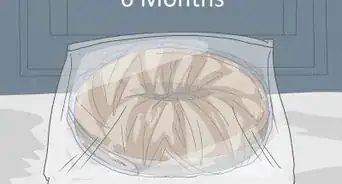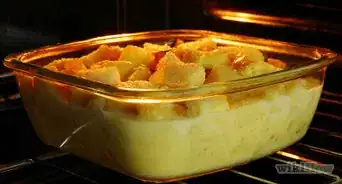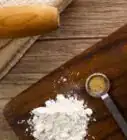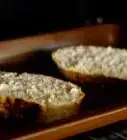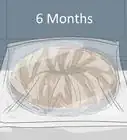This article was co-authored by Quynh La. Quynh La is a Professional Baker and the Owner of Sugar Bakery & Cafe in Seattle, Washington. With over seven years of experience, she specializes in baking cakes, cookies, croissants, and bread. Quynh holds an AAS in Culinary Arts from South Seattle College and a second AAS in Specialty Desserts & Bread from Seattle Central College.
wikiHow marks an article as reader-approved once it receives enough positive feedback. In this case, 92% of readers who voted found the article helpful, earning it our reader-approved status.
This article has been viewed 48,477 times.
Sourdough bread is bread leavened using only wild, naturally-occurring yeast and bacteria. For millennia, this was the only way bread was produced, because knowledge of microscopic life had not been developed, and so yeast was not cultured and sold intentionally. Sourdough bread has a wonderful flavor and can be made with the most basic of ingredients. By following a few simple steps, you can quickly learn how to make sourdough bread of your own.
Ingredients
- Flour
- Water
- Salt
Steps
Preparing the Sourdough Starter
-
1Select a container for your starter. A "starter" is a slurry of flour and water, and it provides the vehicle in which your yeast will propagate.[1] You need a high concentration of yeast to leaven your bread, so you have to get a colony going before you can start baking. Any glass or plastic container with a lid will work for a sourdough starter.
- Canning jars are excellent, as are empty pickle or jam jars.
- Be sure the jar is clean, so the started doesn't get contaminated.
-
2Fill the container with equal parts flour and water.[2] Mix equal parts flour and water in a separate bowl (the amounts aren't important, as long as you mix enough to fill your jar most of the way). Stir until thoroughly blended. Pour the mixture into your starter jar, leaving just a little room for air.
- Any type of flour will do, but remember that you need a good amount of gluten for your bread to rise properly (wheat, barley, and rye contain gluten).
Advertisement -
3Place the container in a warm, dark location.[3] There will be plenty of yeast in your mixture already, as they are present in the air and in the flour. Yeast like 4 things in order to reproduce: warmth, darkness, water, and starch or sugar. You have now provided all of those things, so your yeast should begin to reproduce rapidly. Leave the jar (with the lid on) alone for 24 hours.
- Room temperature is usually warm enough to provide the right conditions for yeast to grow. If your house is on the colder side, place the jar in a warm part of the kitchen.
- Cover the yeast jar with a heavy cloth to keep it dark.
-
4Feed your yeast every 24 hours. Once a day, pour half of the mixture out and replace it with a fresh batch of a mixture of half water, half flour.[4] Within a week, your starter will develop a bubbly froth and a pronounced sour smell. When this happens, your starter is done, and you are ready to bake.
-
5Place the starter in the refrigerator. If you don't want to use the starter right away, park your jar in the refrigerator. Your yeast will stay alive in the cold, but they will remain in a state of sluggish dormancy. The starter can be left in the refrigerator indefinitely if you feed it once a week following the procedure outlined above.
Making Sourdough
-
1Proof your sponge. To do this, pour the entire starter into a mixing bowl and add equal parts flour and water to it, stirring to combine. The total amount of water you add should not exceed the amount of water called for in your bread recipe. 1 cup (236 ml) is a good amount for a loaf of bread. Cover the bowl with a towel, and let the yeast propagate for several hours. This process is called "proofing." The resulting slurry is called a "sponge."
-
2Mix in flour and salt. When your sponge is bubbly, you are ready to mix in the rest of your ingredients. Add a pinch or 2 of salt, and then gradually stir in flour until the dough holds together but is still sticky.
- Flour varies in absorbency, so using exact measurements isn't nearly as useful as relying on your judgment.
- You can mix the dough together easily using nothing but your hands and the mixing bowl.
-
3Cover the bowl with a towel and let the dough rise for several hours. The yeast will work at different rates depending on conditions, so be patient. When your dough has doubled in volume, it's ready for the next step.
- Dough rises faster when it's in a warm, dry place. If your kitchen is cool, turn on the oven to 200 degrees Fahrenheit, tilt the door open a few inches, and place the bowl inside while the dough rises.
- You can let the dough rise in the refrigerator overnight.
Finishing the Bread
-
1Knead the dough. Spread some flour on a clean countertop and place the dough onto it. Punch the dough down and massage it, continuing for about 10 minutes. Add flour when necessary to prevent the dough from sticking to your hands.
- The dough should begin to look glossy and smooth. Keep punching the dough until the consistency looks right.
- You can use a stand mixer with a dough hook attachment instead of your hands.
-
2Let the dough rise again. Form the dough into a ball and cover it with a towel. Allow it to sit and rise until doubled in volume. Meanwhile, preheat your oven to 425 degrees Fahrenheit (218 degrees Celsius).
-
3Bake the bread. When the dough has doubled in volume, place it on a baking sheet, in a loaf pan, or in a heavy pot, and put it in the oven. Let it bake for 45 minutes at 425 degrees Fahrenheit (218 degrees Celsius). Remove the bread when it's done and let it sit for at least 10 minutes before cutting it.
Expert Q&A
-
QuestionWhat materials do you need to make a sourdough starter?
 Quynh LaQuynh La is a Professional Baker and the Owner of Sugar Bakery & Cafe in Seattle, Washington. With over seven years of experience, she specializes in baking cakes, cookies, croissants, and bread. Quynh holds an AAS in Culinary Arts from South Seattle College and a second AAS in Specialty Desserts & Bread from Seattle Central College.
Quynh LaQuynh La is a Professional Baker and the Owner of Sugar Bakery & Cafe in Seattle, Washington. With over seven years of experience, she specializes in baking cakes, cookies, croissants, and bread. Quynh holds an AAS in Culinary Arts from South Seattle College and a second AAS in Specialty Desserts & Bread from Seattle Central College.
Professional Baker You just need flour and water to make a sourdough starter! Some people like to use other ingredients to start their sourdough, like grapes or beer, but you don't have to use these.
You just need flour and water to make a sourdough starter! Some people like to use other ingredients to start their sourdough, like grapes or beer, but you don't have to use these. -
QuestionWill tap water work?
 Cheri111Community AnswerAs a general rule, if you drink your tap water, your sourdough probably can, too. However, if it's chlorinated, it might not work because sourdough is supposed to be a colony of healthy bacteria, and water is chlorinated to kill bacteria. So if you have chlorinated water, consider at least starting your sourdough starter with other water such as spring water. Once you have a healthy starter established, then you can experiment by dividing your starter into two jars and using chlorinated water for one jar and spring water for the other. After you do this for a few weeks, you should be able to tell if the chlorine is hindering the sourdough at all.
Cheri111Community AnswerAs a general rule, if you drink your tap water, your sourdough probably can, too. However, if it's chlorinated, it might not work because sourdough is supposed to be a colony of healthy bacteria, and water is chlorinated to kill bacteria. So if you have chlorinated water, consider at least starting your sourdough starter with other water such as spring water. Once you have a healthy starter established, then you can experiment by dividing your starter into two jars and using chlorinated water for one jar and spring water for the other. After you do this for a few weeks, you should be able to tell if the chlorine is hindering the sourdough at all.
Warnings
- Don't use a metal container for your sourdough starter. Some metals are reactive and can ruin your starter.⧼thumbs_response⧽
Things You'll Need
- Glass jar
- Flour
- Water
- Mixing bowl
- Wire whisk
- Towel
- Salt
- Baking sheet
References
About This Article
If you've already prepared your starter and are ready to make sourdough bread, place the starter in a bowl and add equal amounts of flour and water. Next, leave the mixture to proof for several hours before adding the remaining flour and salt. Allow the dough to rise for another few hours, then knead it into a ball. When the dough appears smooth, leave it until it doubles in volume. Finish by placing your bread on a baking sheet and baking at 425 degrees F for 45 minutes. For advice on how to prepare your starter for sourdough bread, read on!

